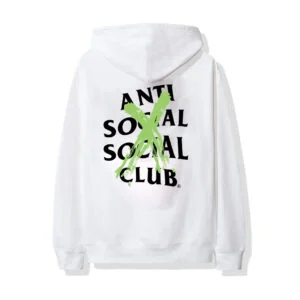The world of streetwear is filled with mystery, exclusivity, and controversy, but few brands have stirred as much curiosity and debate as Anti Social Social Club (ASSC). While the brand’s public image has been built on hype drops and limited releases, the real story behind its meteoric rise—and its equally polarizing reputation—is something streaming platforms like Netflix have hesitated to showcase. This is the untold story Netflix doesn’t want you to see, a deep dive into the inner workings, scandals, and behind-the-scenes drama of Anti Social Social Club.
The Origins: From a Personal Outlet to a Global Phenomenon
Founded in 2015 by Neek Lurk, a former social media and brand director at Stüssy, Anti Social Social Club started as nothing more than a personal expression of anxiety and depression. The name itself reflected Lurk’s introspective struggles, but in an age dominated by Instagram culture, the moody branding resonated far beyond his inner circle.
In its earliest days, the brand operated almost like a secret club. Limited quantities, minimalist designs, and the raw emotional honesty of its message struck a chord with a generation seeking authenticity. Within just a few months, celebrities like Kanye West, Kim Kardashian, and Travis Scott were spotted wearing the label, cementing its place in the high-demand streetwear scene.
The Business Model Netflix Won’t Show You
While most documentaries highlight success stories in a flattering light, the truth behind ASSC’s business model is far more complicated. Built on scarcity, hype, and unpredictability, the brand mastered the art of creating demand by restricting supply.
However, this same model led to one of the most notorious reputations in streetwear retail—customers often complained about delayed shipments, wrong orders, and poor customer service. Rather than addressing these issues head-on, the brand doubled down on its “you get it when you get it” mystique, almost making the chaos part of its identity.
For many insiders, this wasn’t incompetence—it was marketing. Delays fueled online chatter, outrage kept the brand in the spotlight, and every drop still sold out within minutes.
The Celeb Factor and Cultural Takeover
If there’s one thing Anti Social Social Club excelled at, it was hijacking pop culture. Without traditional advertising, the brand leveraged influencers, rappers, and high-profile collaborations to push its visibility. From collabs with BAPE and Playboy to a Porsche partnership, ASSC’s drop list reads like a luxury-meets-streetwear fantasy.
Netflix documentaries often present celebrity endorsements as organic, but in ASSC’s case, strategic placements were everything. Neek Lurk had an uncanny ability to get pieces into the hands of the right people at the right time—often ahead of a major album drop or viral moment.
The Dark Side: Lawsuits, Refund Controversies, and Public Backlash
No exposé would be complete without addressing the brand’s troubled customer service history. Between 2017 and 2020, forums, Reddit threads, and social media posts exploded with complaints. Buyers reported waiting six months or more for orders, receiving incorrect items, or not getting their purchases at all.
In 2019, the Better Business Bureau rated the brand an F due to the sheer volume of unresolved complaints. For most companies, this would have been catastrophic. For ASSC, it became part of the myth. Fans began wearing the frustration as a badge of honor—if you actually received your order, you were one of the “chosen ones.”
Inside the Mind of Neek Lurk
While Netflix might shy away from portraying controversial founders in too much detail, Neek Lurk’s role is central to the ASSC story. Known for his enigmatic social media presence and abrupt disappearances from the public eye, Lurk cultivated an air of mystery that perfectly aligned with the brand’s ethos.
Insiders claim that Lurk’s leadership style was chaotic yet visionary. He understood internet culture better than most fashion executives, using memes, cryptic posts, and pop culture references as tools to build hype. In many ways, his mental health struggles—publicly acknowledged through the brand’s messaging—were both a source of inspiration and an unpredictable business variable.
Collaborations That Shocked the Industry
One of the defining features of Anti Social Social Club is its unpredictable collaborations. Unlike other streetwear brands that maintain a consistent aesthetic partner base, ASSC jumped across industries:
- Porsche – A luxury automotive collaboration that stunned the fashion world.
- Hello Kitty – A quirky partnership blending melancholy branding with an iconic Japanese character.
- Playboy – A provocative mix of nostalgia and pop culture.
- BAPE – The ultimate streetwear power move, merging two hype machines into one drop.
These collaborations often sold out in minutes, further cementing the brand’s legendary status.
Why Netflix Wouldn’t Touch This Story
So, why would Netflix avoid a documentary like this? Two reasons stand out:
- Legal Risks – The brand’s history of customer complaints and unresolved disputes could open the door to defamation claims.
- Brand Control – ASSC thrives on being misunderstood. A transparent, behind-the-scenes look might strip away the mystique that drives its hype.
By keeping its inner workings under wraps, Anti Social Social Club ensures that its myth remains intact—and myths are far more valuable than transparency in streetwear culture.
The Cult-Like Fan Base
Perhaps the most intriguing element of the ASSC phenomenon is its loyal yet conflicted fan base. Despite widespread criticism, the brand’s drops still vanish within minutes. Fans justify their loyalty by pointing to the cultural value, exclusivity, and resale potential of each piece.
In the resale market, ASSC hoodies can fetch two to three times their retail price—especially rare collab items. This secondary economy fuels even more hype, ensuring that every drop is an event.
The Legacy and Future of Anti Social Social Club
Whether you see it as a marketing genius or a cautionary tale, Anti Social Social Club has changed the rules of streetwear. Its blend of emotional branding, deliberate scarcity, and pop culture infiltration has made it both loved and hated in equal measure.
